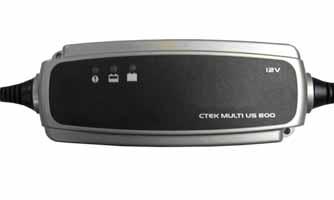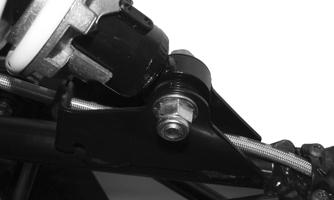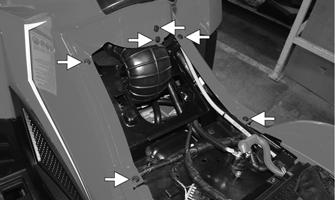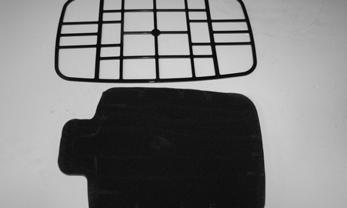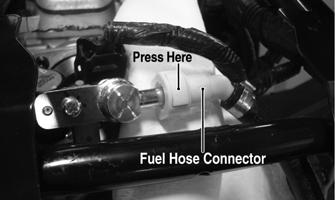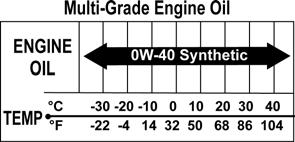
37 minute read
Drive System/Brake System
GENERAL INFORMATION The die-cast aluminum housings have been assembled with thread-rolling screws (trilobular). When assembling with these screws, start the screws carefully into the housing; then use the following torque values:
Size New Housing Reassembled Housing
M6 (Torx T-30 Recess) 8-9.5 ft-lb 6.5-9 ft-lb (10.9-12.9 N-m) (8.8-12.2 N-m) M8 (Torx T-40 Recess) 25-31 ft-lb 21-25 ft-lb (34-42.2 N-m) (28.6-34 N-m) M10 (Torx T-50 Recess) 37-45.5 ft-lb 31-38 ft-lb (50.3-61.7 N-m) (42.2-51.7 N-m)
Description p/n
Backlash Measuring Tool (24-Spline Axle) 0544-010 Backlash Measuring Tool (27-Spline Axle) 0544-011 CV Boot Clamp Tool 0444-120 Hub Retaining Wrench 0444-270 Internal Hex Socket 0444-104 Pinion Gear/Shaft Removal Tool 0444-127 Gear Case Seal Installer Tool 0444-224
SPECIAL TOOLS A number of special tools must be available to the technician when performing service procedures in this section. NOTE: When indicated for use, each special tool will be identified by its specific name, as shown in the chart below, and capitalized.
NOTE: Special tools are available from the Service Department.
Front Drive Actuator/Differential Lock
NOTE: The actuator is only serviceable as an assembly. NOTE: The actuator will operate only when the ignition switch is in the ON position. The front drive actuator is located on the side of the front drive input housing. With the engine stopped and the ignition switch in the ON position, a momentary “whirring” sound can be heard each time the drive select switch is shifted or the differential lock is activated. If no sound is heard, see Electrical System. If the actuator runs constantly or makes squealing or grinding sounds, the actuator must be replaced. REMOVING 1.Lift the vehicle and support with jack stands; then remove both front wheels. 2.Remove both upper A-arm cap screws and lock nuts.
Discard the lock nuts.
XR329
3.Remove the cap screws and lock nuts securing the
A-Arm brace to the frame. Discard the lock nuts.
Remove the A-Arm brace.
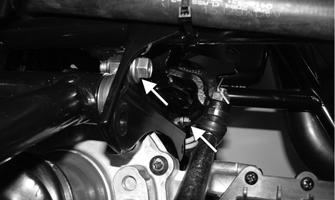
XR330A
4.Remove the two cap screws and nuts securing the front differential to the frame. Account for the washers and their location. 5.Disconnect the actuator from the main harness. 6.Using a T-30 Torx wrench, remove the mounting cap screw from the driveshaft side of the actuator.
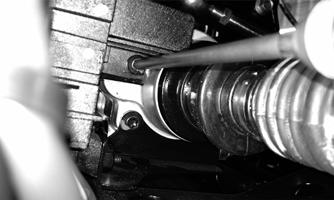
XR331
7.Lift the differential up to gain access to the cap screw on the suspension side. Remove the cap screw.
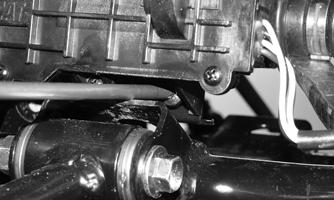
XR332
8.Loosen but do not remove the mounting cap screw at the front of the actuator; then slide the actuator to the rear enough to clear the slotted mounting tab and the selector shaft.
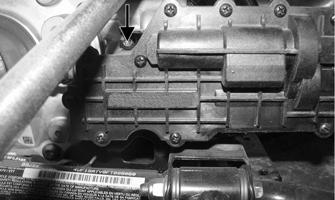
XR164A
INSTALLING NOTE: Make sure to properly align the differential lock actuator lever with the hole in the differential lock plunger. 1.Lubricate the O-rings on the actuator; then ensure that all mounting surfaces are clean and free of debris. 2.Align the actuator with the selector shaft and slide it forward onto the shaft taking care to engage the cap screw in the slot of the front mounting tab.
XR164A
3.While holding the actuator firmly forward, tighten the front cap screw to hold the actuator in place; then install but do not tighten the two remaining cap screws.

XR331
NOTE: It is important to tighten this cap screw while the others are loose to ensure proper seating of the actuator.
5.Tighten the remaining cap screws; then connect the electrical plug to the main harness. 6.Turn the ignition switch to the ON position and check the operation by shifting the drive select switch several times. 7.Secure the wiring harness to the frame with a nylon cable tie.
Front Differential
REMOVING DIFFERENTIAL 1.Secure the ATV on a support stand to elevate the wheels.
! WARNING
Make sure the ATV is solidly supported on the support stand to avoid injury.
2.Remove the drain plug and drain the gear lubricant into a drain pan; then reinstall the plug and tighten to 45 in.-lb (5 N-m).
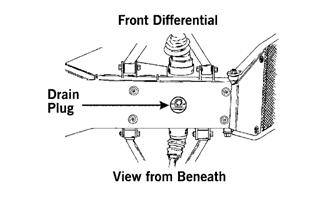
ATV0082A
3.Remove the front wheels. 4.Pump up the hand brake; then engage the brake lever lock.

KX041
6.Release the brake lever lock.
NOTE: It is not necessary to remove the brake hoses from the calipers for this procedure. 7.Remove the two brake calipers. Account for the four cap screws.
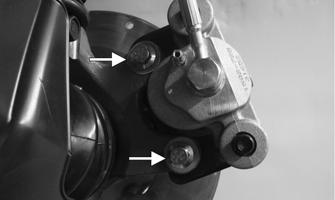
XR263A
NOTE: Do not allow the brake calipers to hang from their cable/hose.
8.Remove the tie rod cotter pins and discard the pins.
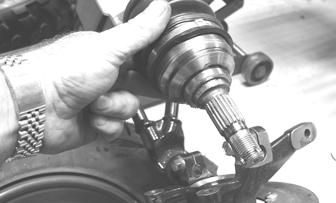
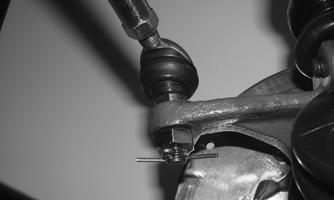
XR337
9.Remove the tie rod lock nuts.
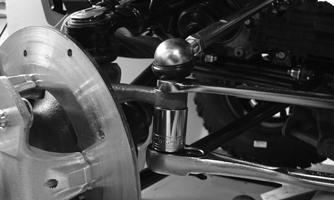
XR338
10.Remove the upper ball joint cap screws taking care not to strip the threads on the ball joint shaft; then using a rubber mallet, tap the end of the axle and free it from the knuckle assembly.
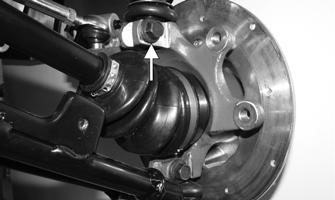
XR339A
11.Pull the steering knuckle away from the axle.
KX151
12.Support the axle to not allow it to drop or hang.
13. Remove the lower shock bolts. Account for the lock nuts; then move the shocks aside and secure them with a strap. CAUTION
The axle must be supported. If the axle is allowed to drop or hang, damage to the inner CV joint may occur.

XR340
14.Remove the upper A-arm lock nuts and cap screws; then remove the A-arms.
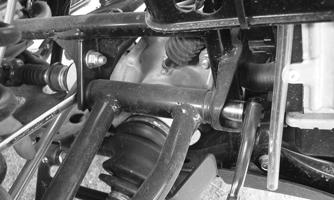
CF661
15.Remove the cap screws and lock nuts securing the
A-arm brace to the frame. Discard the lock nuts.

XR330A
16.Push the axle shaft firmly toward the differential to release the internal lock; then while holding the axle in, pull the CV cup from the differential. NOTE: Keeping the axle level will aid in removal.
CAUTION
Do not attempt to use a slide hammer or differential/axle damage will occur.
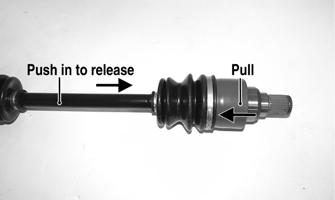
CF633A
17.Remove the differential mounting cap screws.
Account for the washers and discard the nuts.
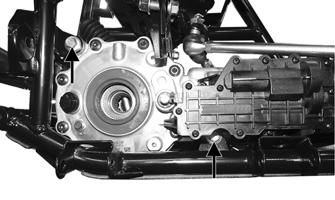
CF650A
18.Using a T-30 Torx wrench, remove the three screws securing the front drive actuator to the gear case; then remove the actuator.
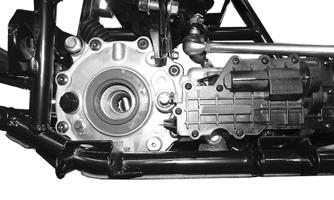
CF650
19.Remove the front two shoulder screws securing the front of the skid plate to the frame.

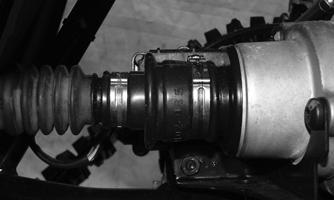
XR343
21.Free the differential assembly from the frame; then shift the differential assembly forward enough to disengage the front driveshaft from the output yoke.
Remove the front output shaft from the differential.
Account for the tension spring.
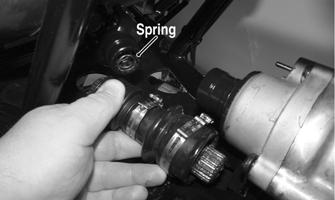
XR345A
22.Turn the handlebar toward the left; then remove the left hand tie rod end from the bottom of the steering arm. Discard the cotter pin.
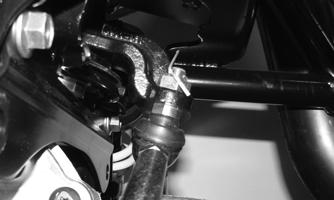
XR344
23.Place the differential on its right side; then remove it from the frame.
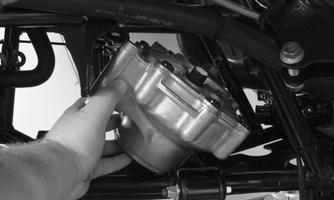
XR346
Disassembling Input Shaft NOTE: This procedure can be performed on a rear gear case; however, some components may vary from model to model. The technician should use discretion and sound judgment. 1.Using a T-40 Torx wrench, remove the cap screws securing the pinion housing.
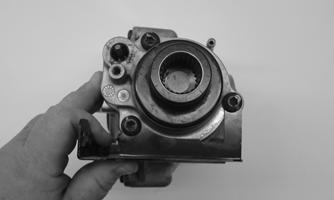
XR347
2.Using a rubber mallet, remove the housing. Account for a gasket. Remove the fork, shift fork shaft with
O-ring, coupler, and spring. Note the location of all the components for assembling purposes.
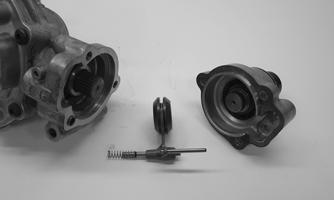
XR348
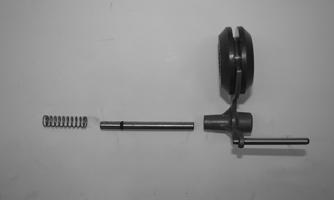
XR352
3.Using a boot-clamp pliers (or suitable substitute), remove the boot clamps; then remove the boots and splined drive from the input shaft. 4.Remove the snap ring; then remove the input shaft from the pinion housing.
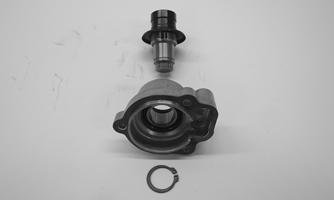
XR349
5.Using a seal removal tool, remove the input shaft seal. Account for a spacer.
GC010
6.Remove the snap ring securing the input shaft bearing; then place the pinion housing in a press and remove the bearing.
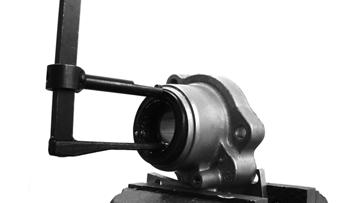
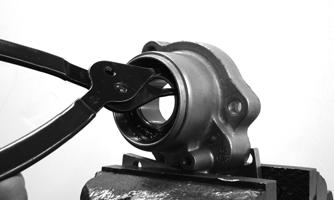
GC011
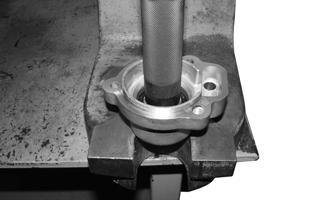
XR350
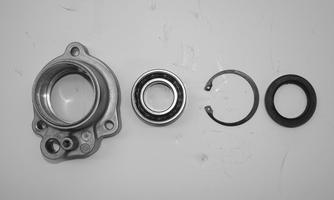
XR351
Assembling Input Shaft 1.Place the pinion housing in a press and install the input shaft bearing. Secure the bearing with the existing snap ring making sure the sharp edge of the snap ring faces to the outside.
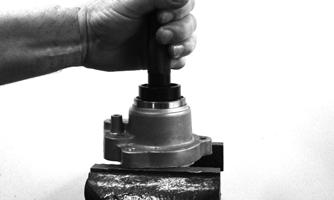
GC012

GC011
2.Install the input shaft seal making sure it is fully seated in the housing.
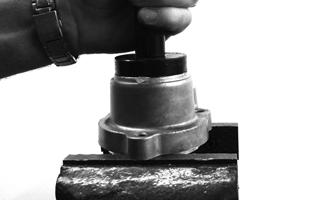
GC014
NOTE: Any time drive splines are separated, clean all splines with parts-cleaning solvent and dry with compressed air; then lubricate with recommended grease. 3.Grease the pinion housing seal; then install the input shaft into the pinion housing and secure with the snap ring.
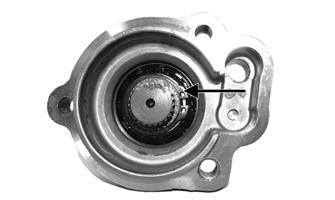
GC009A
4.With the return spring over the shuttle shaft, place the shuttle shaft with O-ring into the differential housing.
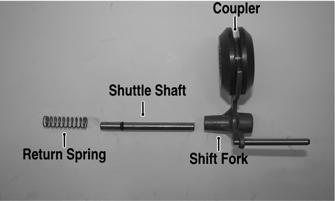
XR352A
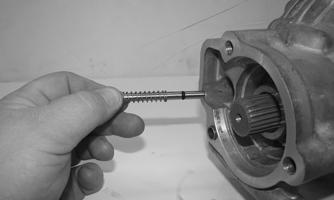
XR354
5.Place the dowel pin into the differential housing then install a new gasket. Place the coupler onto the shift fork; then simultaneously engage the shift fork to the shuttle shaft and the internal splines of the coupler to the splines of the pinion gear shaft.
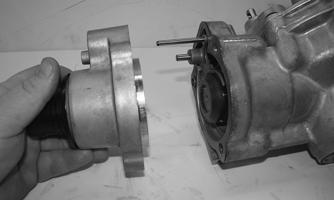
XR353
6.Align the splines of the output shaft to the internal splines of the coupler then place the pinion housing onto the differential housing. If applicable, place the drive actuator bracket into position, secure the assembly with three cap screws and tighten to 23 ft-lb (31.3 N-m) (existing) or 28 ft-lb (38.1 N-m) (new differential housing).

XR347
Disassembling Differential Assembly NOTE: This procedure can be performed on a rear gear case. 1.Using a T-40 Torx wrench, remove the cap screws securing the pinion housing. Account for the coupler, fork, shuttle shaft with O-ring, and spring (differential only).

XR352A
2.Using a T-40 Torx wrench, remove the cap screws securing the differential cover. 3.Using a plastic mallet, tap lightly to remove the differential cover. Account for an O-ring.
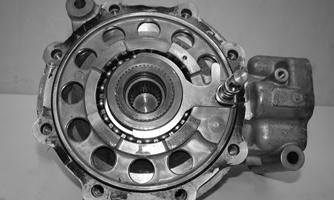
XR355
NOTE: If the cover is difficult to remove, pry on the cover in more than one recessed location.
4.Remove the splined coupler, shifter fork, pin, and spring of the differential lock assembly and set aside.
Note position of parts for assembling purposes.
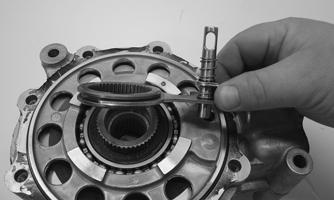
XR356
5.Remove the left differential bearing flange assembly and account for a shim. Mark the shim as left-side.
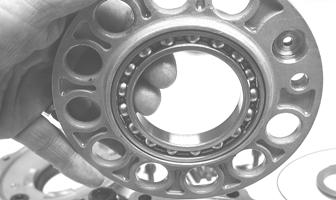
KX177
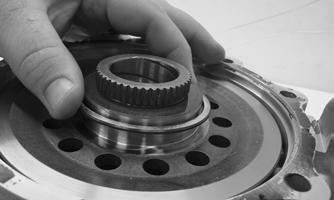
XR357
6.Place the differential with the open side down; then lift the housing off the spider assembly. Account for shim(s) and mark as right-side.
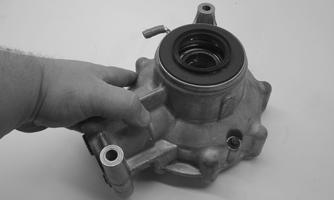
XR358
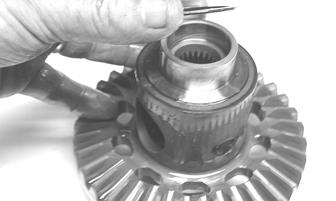
KX181
Disassembling Pinion Gear 1.Remove the internal snap ring securing the pinion bearing in the housing.
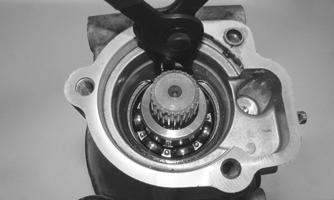
WC430
2.Using the Pinion Gear/Shaft Removal Tool and a hammer, remove the pinion gear from the gear case housing.
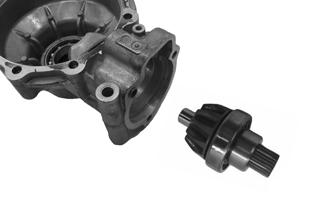
XR359
3.Secure the pinion gear in a bearing puller; then remove the pinion bearing using a press. Account for a collar and a bearing.
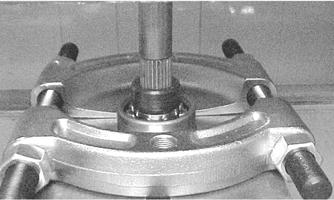
CC879
4.Remove any reusable parts from the gear case housing; then discard the housing and lock collar. Assembling Pinion Gear 1.Install the bearing onto the pinion shaft. Install the pinion shaft collar.
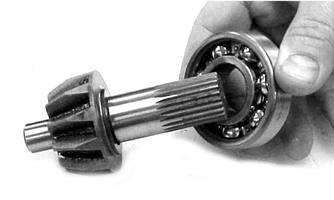
CC882
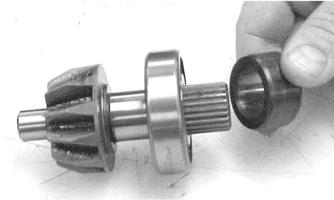
CC883
2. Place the pinion assembly in a bearing puller; then install the bearing using a press.
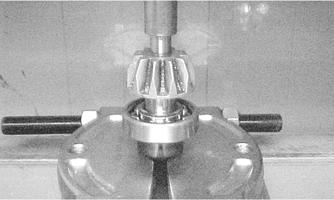
3.Using a propane torch, heat the gear case housing to approximately 200° F (93° C); then install the pinion assembly. 4.Install the internal snap ring with the sharp side directed away from the bearing. To install the pinion housing assembly, see steps 4-6 in Assembling
Input Shaft.

WC429
Shimming Procedure/Shim Selection
Case-side Shims (Backlash) p/n mm in. 0402-405 1.3 0.051 0402-406 1.4 0.055 0402-407 1.5 0.059 0402-408 1.6 0.063 0402-409 1.7 0.067
Cover-side Shims (Ring Gear End-Play) p/n mm in. 1402-074 1.3 0.051 1402-075 1.4 0.055 1402-076 1.5 0.059 1402-077 1.6 0.063 1402-078 1.7 0.067
It is very important to adjust bevel gears for the proper running tolerances. Gear life and gear noise are greatly affected by these tolerances; therefore, it is very important to properly adjust any gear set prior to final assembly. The following procedure can be used on both front differential or rear drive gear case. NOTE: All bearings must be installed in the gear case and the pinion properly installed before proceeding. Backlash NOTE: Always set backlash prior to any other shimming. 1.Install the existing shim or a 0.051-0.055-in. shim on the gear case side of the ring gear assembly. Position the chamfered side of the shim inward.
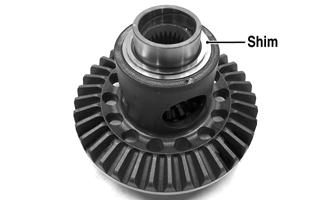
GC031A
2.Install the ring gear with shim in the gear case; then while holding the pinion stationary, rock the ring gear forward and back to determine if any backlash exists. If no backlash exists, install a thicker shim and recheck.
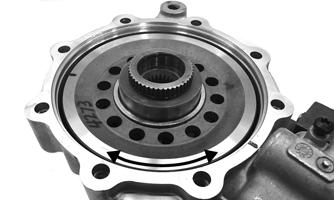
GC036A
3.Install the bearing flange onto the gear case cover making sure the alignment/locating pin engages the locating hole in the cover; then make sure the bearing flange is completely seated in the cover.
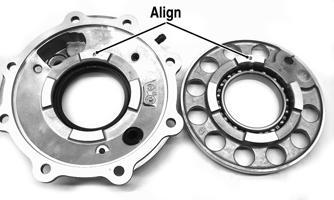
GC032A
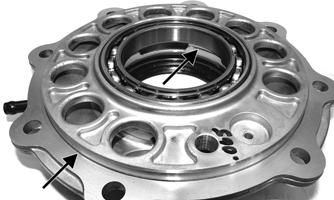
GC033A
4.Install the existing shim (chamfered side positioned inward) or a 0.063 in. shim on the cover side of the ring gear; then place the assembled gear case cover onto the gear case and secure with three cap screws.
Tighten evenly using a crisscross pattern.
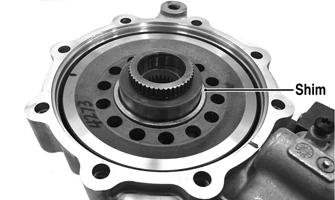
GC036B
5.Place the appropriate Backlash Measuring Tool into the splines of the ring gear and install a dial indicator making sure it contacts the gauge at a 90° angle and on the index mark.
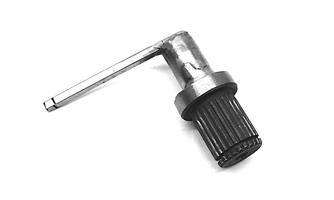
GC040 GC039A
6.Zero the dial indicator; then while holding the pinion stationary, rock the ring gear assembly forward and back and record the backlash. Backlash must be 0.011-0.015 in. If backlash is within specifications, proceed to Ring Gear End-Play. If backlash is not within specifications, increase shim thickness to increase backlash or decrease shim thickness to decrease backlash.
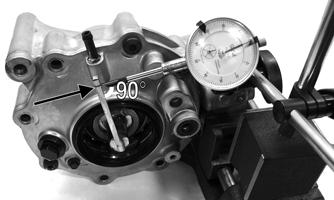
NOTE: Higher backlash settings usually result in quieter gear operation.
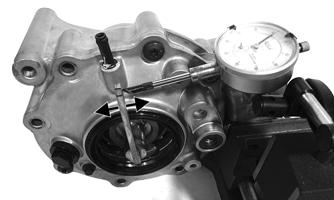
GC037A
Ring Gear End-Play After correcting backlash, ring gear end-play can be adjusted. To adjust end-play, use the following procedure: 1.Secure the gear case in a holding fixture with the cover side up; then install a dial indicator contacting the ring gear axle flange.
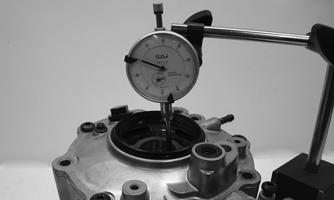
GC035
2.Zero the dial indicator; then push the ring gear toward the dial indicator and release. End-play should be 0.004-0.008 in.
3.To increase end-play, decrease the shim thickness. To decrease end-play, increase the shim thickness. NOTE: Once proper backlash and end play are established, the gear case can be assembled (see Assembling Differential Assembly in this sub-section). Assembling Differential Assembly 1.With the pinion gear and new bearings installed, place the selected (backlash) shim on the gear case side of the ring gear with the chamfered side toward the ring gear; then install into gear case/differential housing.

GC031A
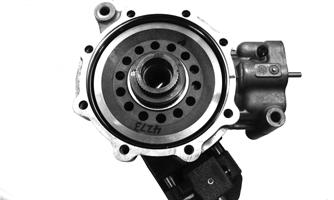
GC020
2.Place the selected (end-play) shim, chamfered side toward the gear, onto the cover side of the ring gear.

GC036B
NOTE: The spider and ring gear assembly must be replaced as a complete unit. 3.Assemble the fork and sliding collar into the cover assembly; then install the left bearing flange/bearing assembly and seat firmly into the cover.
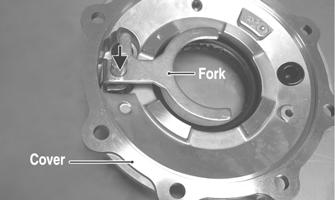
CF266A
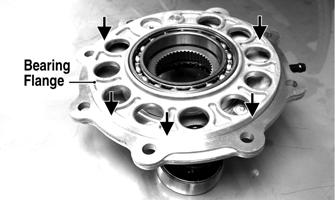
CF267A
4.Apply a liberal coat of grease to the O-ring; then install it on the assembled cover assembly making sure to seat the O-ring completely down around the circumference of the bearing flange.
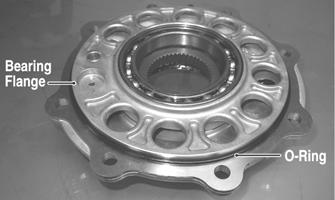
CF275A
5.Making sure the O-ring is properly positioned on the differential housing cover assembly, install the cover with existing cap screws (coated with green Loctite #609). Account for the ID tag. Tighten the cap screws evenly to 23 ft-lb (31.3 N-m) (existing) or 28 ft-lb (38.1 N-m) (new housing). NOTE: Grease can be applied to the O-ring for ease of assembling. 6.Install the shift fork shaft w/spring into the housing making sure the shaft O-ring is positioned to the inside.

XR354
7.Install the shift fork assembly making sure the fork leg is facing upward. Apply a small amount of oil to the gasket; then install the gasket.

XR353
8.Place the input shaft assembly onto the gear case housing; then secure with the existing cap screws.
Tighten to 23 ft-lb (31.3 N-m) (existing) or 28 ft-lb (38.1 N-m) (new housing).

XR347
Removing/Installing Axle Seal NOTE: This procedure can be performed on a rear gear case. 1.Remove the seal using a seal removal tool.
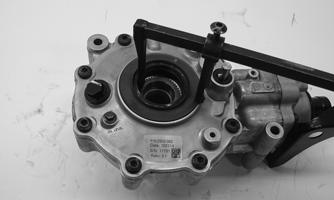
XR360
NOTE: Prior to installing the seal, apply High-Performance #2 Molybdenum Disulfide grease to the seal’s outside diameter.
2.Using Gear Case Seal Installer Tool, evenly press the seal into the cover bore until properly seated.
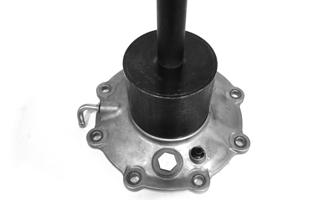
GC060
CAUTION
Make sure the tool is free of nicks or sharp edges or damage to the seal may occur.
3. Repeat steps 1-2 for the opposite side. INSTALLING DIFFERENTIAL 1.From the right side of the vehicle, insert the differential into the frame. With the driveshaft boots installed, place the driveshaft into the differential.
Place the tension spring into the front yoke.
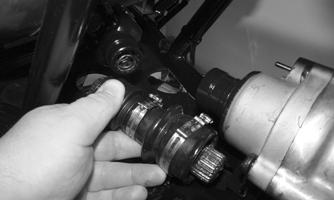
XR345
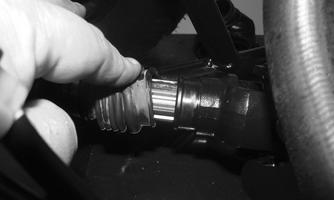
XR361
2.Position the differential forward enough into the frame; then align the splines of the driveshaft into the front yoke. Secure the boot clamps. 3.Apply red Loctite to the threads of the left tie rod inner ball joint; then install to the lower steering arm.
Tighten to 30 ft-lb (40.8 N-m). Install a new cotter pin. 4.Loosely install the front cap screw into the differential; then install the 4WD drive actuator. Engage the 4WD differential lock shift arm into the lock collar post. Fully seat the actuator on to the differential by pushing it forward. Tighten the top left actuator cap screw to hold it place.

XR164A
5.Install the rear actuator retaining cap screw; then lift the differential to install the remaining retaining cap screws.


XR331
6.Secure the differential to the frame using the cap screws, washers, and lock nuts to the frame. Tighten to 38 ft-lb (51.7 N-m). 7.Install each half shaft into the differential. 8.Position the A-arm brace onto the frame using the cap screws and new lock nuts. Finger tighten only at this point. 9. Secure the upper arm to the frame with the cap screws and new lock nuts. Tighten the A-arms to 50 ft-lb (68
N-m); then tighten the A-arm brace to 50 ft-lb (68
N-m). 10.Slide the CV joint into the wheel bearings; then secure the ball joints to the knuckle with the required cap screws. Using a new lock nut, secure the lower shock eyelet to the upper A-arm. Repeat for opposite side. Tighten the ball joint cap screw to 35 ft-lb (47.6
N-m). Tighten the shock the to upper A-arm to 50 ft-lb (68 N-m).

XR339A
11.Apply red Loctite to the threads of the outer tie-rod.
Using a new lock nut and cotter pin, secure to the knuckle. Tighten to 35 ft-lb (47.6 N-m). Repeat for opposite side. 12.Install the hubs the to half shafts. Tighten the hub nuts to 200 ft-lb (271 N-m). Use a new cotter pin. 13.Using new patch lock cap screws, secure each caliper to the knuckles. Tighten to 20 ft-lb (27.2 N-m).
XR263A
14.Install the wheels; then using a crisscross pattern, tighten the wheel nuts in 20 ft-lb (27.2 N-m) increments to a final torque of 40 ft-lb (54.4 N-m) (steel wheel), 60 ft-lb (81.6 N-m) (aluminum wheel w/black nuts), or 80 ft-lb (108.8 N-m) (aluminum wheel w/chrome nuts).
REMOVING REAR DRIVE AXLE 1.Secure the ATV on a support stand to elevate the wheels.
! WARNING
Make sure the ATV is solidly supported on the support stand to avoid injury.
2.Pump up the hand brake; then engage the brake lever lock. 3.Remove the wheel. 4.Remove the cotter pin securing the hex nut; then remove the hex nut. Release the brake lever lock.
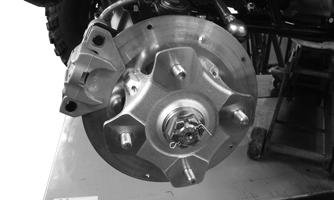
XR291
5.Remove the brake caliper. NOTE: Do not allow the brake calipers to hang from their cable/hose.
CAUTION
The calipers should be supported. If the calipers are allowed to hang from the cable/hose, damage may occur.
6.Slide the hub out of the knuckle and set aside. 7.Remove the cap screw securing the knuckle to the upper A-arm ball joint. Discard the lock nut. 8.While holding the drive axle stationary, pull the top of the knuckle out and down until it is free of the drive axle. 9.Place a drain pan under the ATV to contain any oil leakage. 10.Push the axle shaft firmly toward the gear case to release the internal lock; then while holding the axle in, pull the CV cup from the gear case. NOTE: Keeping the axle level will aid in removal.
CAUTION
Do not attempt to use a slide hammer or gear case/axle damage will occur.

CF633A
REMOVING FRONT DRIVE AXLE NOTE: For removing a front drive axle, see Front Differential in this section.
CLEANING AND INSPECTING NOTE: Always clean and inspect the drive axle components to determine if any service or replacement is necessary. 1.Using a clean towel, wipe away any oil or grease from the axle components.
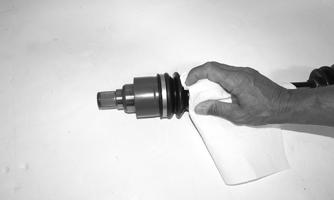
CF635
2.Inspect boots for any tears, cracks, or deterioration. NOTE: If a boot is damaged in any way, it must be replaced with a boot kit. 3.Inspect the gear case seals for nicks or damage. DISASSEMBLING AXLES NOTE: Only the boots are serviceable on the axles; if any other component is worn or damaged, the axle must be replaced. 1.Using CV Boot Clamp Tool, remove both clamps.
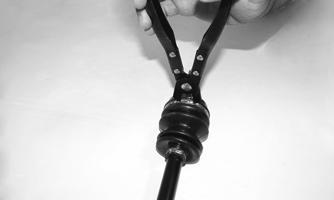
CF636
2.Place the end of the CV-joint into a vise. Use soft jaws or duct tape to protect the surface of the
CV-joint.
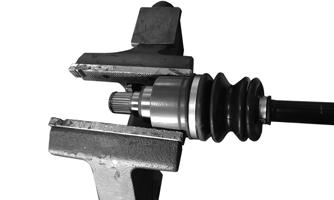
CF638
3.To disengage the axle from the CV joint, sharply pull back on the axle; then slide the boot off of the axle.
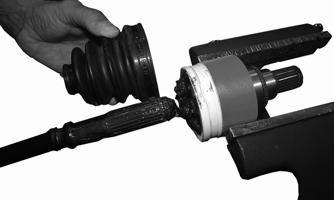
CF637
NOTE: Steps 1-3 can be used to replace the outboard boot.
ASSEMBLING AXLES 1.Install the boot with the small clamp onto the axle, making sure the ends of the clamp are positioned correctly. 2.Align the splines of the half shaft into the CV joint; then push the half shaft firmly into the CV joint. 3.Verify the half shaft is seated into the CV joint by lightly pulling the half shaft outward. The half shaft should not slide out.
NOTE: The boot is positioned correctly when the small end of the boot seats down into the recessed groove.
ATV-1048
5.Apply 80 grams (2/3 of contents) of grease from the pack into the bearing housing. NOTE: Steps 1-3 can be used to replace the outboard boot.
6.Using the boot clamp tool, secure the large clamp of the inner boot to the CV joint.
CF636
NOTE: In the outboard boot, use the final 40 grams (1/3 of contents) of grease from the pack in the bearing housing. INSTALLING REAR DRIVE AXLE 1.Push the axle shaft into the CV cup to release the detent balls; then while holding the axle firmly in, push the CV splined end into the gear case.

CF633A
NOTE: To ensure proper seating of the axle, give it a light pull; the axle should remain “clipped” in place.
2.Swing the knuckle up and onto the drive axle; then place the knuckle into place in the upper A-arm.
Secure the knuckle to the A-arm with a cap screw and a new lock nut. Tighten to 50 ft-lb (68 N-m). 3.Place the hub into position on the axle followed by a hex nut. Tighten the hex nut only until snug at this time. 4.If the brake caliper was removed, position it on the knuckle and secure with new “patch-lock” cap screws. Tighten to 20 ft-lb (27.2 N-m). 5.Pump up the hand brake lever; then engage the brake lever lock. 6.Using an appropriate spanner wrench, tighten the hub nut (from step 3) to 200 ft-lb (271 N-m); then install and spread a new cotter pin making sure each side of the pin is flush to the hex nut. NOTE: If the cotter pin does not line up, always tighten to the next alignment.

XR291
7.Install the wheel and tighten the wheel nuts in 20 ft-lb (27.2 N-m) increments to a final torque of 40 ft-lb (54.4 N-m) (steel wheel), 60 ft-lb (81.6 N-m) (aluminum wheel w/black nuts), or 80 ft-lb (108.8
N-m) (aluminum wheel w/chrome nuts). 8.Remove the ATV from the support stand and release the brake lever lock. INSTALLING FRONT DRIVE AXLE 1.Position the drive axle in the gear case and steering knuckle; then insert the upper A-arm ball joint into the steering knuckle. Secure with a cap screw tightened to 30 ft-lb (40.8 N-m). 2.Place the brake hose into position on the upper
A-arm; then secure the lower shock eyelet to the
A-arm with a cap screw and a new lock nut. Tighten to 50 ft-lb. 3.Secure the tie rod to the steering knuckle with a new lock nut. Tighten securely; then install and spread a new cotter pin. 4.Slide the hub w/brake disc into position over the end of the axle followed by a washer and hex nut.
Tighten finger-tight at this time. 5.Install the brake caliper on the steering knuckle using new “patch-lock” cap screws. Tighten to 20 ft-lb (27.2 N-m); then pump up the hand brake lever and engage the brake lever lock.
6.Using an appropriate spanner wrench, tighten the hub nut (from step 4) to 200 ft-lb (271 N-m); then install and spread a new cotter pin making sure each side of the pin is flush to the hex nut. NOTE: If the cotter pin does not line up, always tighten to the next alignment.
XR291
7.Install the wheel and tighten the wheel nuts in 20 ft-lb (27.2 N-m) increments to a final torque of 40 ft-lb (54.4 N-m) (steel wheel), 60 ft-lb (81.6 N-m) (aluminum wheel w/black nuts), or 80 ft-lb (108.8
N-m) (aluminum wheel w/chrome nuts). 8.Remove the ATV from the support stand and release the brake lever lock. 9.Check the front differential oil level and add oil as necessary (See Periodic Maintenance/Tune-up).
Rear Gear Case
REMOVING 1.Lift the rear of the vehicle up and support it with jack stands. Remove the wheel hubs and rear brake caliper. Drain the oil from the gear case. 2.Remove both of the rear drive axles (see Drive Axles in this section). 3.Remove the four cap screws securing the output shaft to the rear gear case flange. Remove the CVT exhaust duct assembly. Disconnect the vent hose from the gear case.
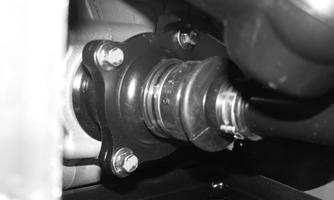
XR303
4.Remove the two cap screws and lock nuts securing the rear gear case to the frame; then remove the gear case through the left side. Account for the washers and their placement.
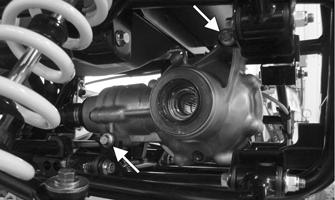
XR362A
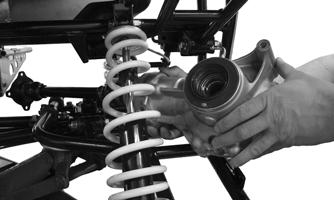
XR363
AT THIS POINT
For servicing the input shaft, pinion gear, needle bearing, ring gear, and axle seal, see Front Differential in this section.
RING GEAR/THRUST BUTTON Removing 1.Remove the cap screws securing the gear case cover to the gear case; then remove the ring gear. 2.Remove the thrust button from the gear case cover (left-hand threads). Account for a shim. Inspecting 1.Inspect the ring gear for excessive wear, missing or chipped teeth, or discoloration. 2.Inspect the thrust button for excessive wear or discoloration. 3.Inspect the bearings for discoloration, roughness, or excessive wear.
NOTE: For servicing bearings or seals, see Front Differential in this section.
Installing/Shimming NOTE: Ring gear clearance must be adjusted prior to selecting shim for the thrust button. 1.Install the thrust button with shim into the gear case cover and tighten securely (left-hand threads).
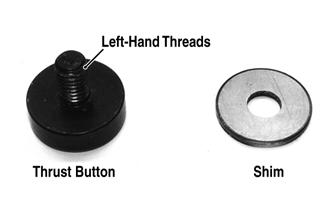
GC057A
2.Place the ring gear with selected shim into the cover and measure the ring gear to thrust button clearance with a thickness gauge. Clearance should be 0.020-0.040 in (0.51-1.02 mm).
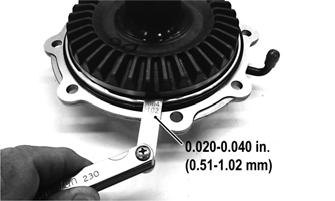
GC058A
3.If clearance is as specified, remove the ring gear and thrust button; then place a drop of red Loctite #271 on the threads and tighten to 8 ft-lb (10.9 N-m) (left-hand threads). 4.If clearance is not as specified, repeat steps 1 and 2 using thicker (clearance too great) or thinner (clearance too small) until correct specification is reached. Rear Gear Case Installation 1.Place the gear case into position and install into the frame with the cap screws, washers, and new lock nuts. Finger tighten only at this point.
XR363
2.Align and install the four cap screws securing the propeller shaft flange to the engine flange. Tighten the differential fasteners to 38 ft-lb (51.7 N-m); then secure the drive flange cap screws to 20 ft-lb (27.2
N-m).

XR303
3.Connect the bladder to the gear case. 4.Install both rear drive axles (see Drive Axles). 5.Install the hubs, rear brake caliper and wheels.
Tighten the brake caliper cap screws to 20 ft-lb (27.2
N-m) increments to a final torque of 40 ft-lb (54.4
N-m) (steel wheel), 60 ft-lb (81.6 N-m) (aluminum wheel w/black nuts), or 80 ft-lb (108.8 N-m) (aluminum wheel w/chrome nuts).
Hub
REMOVING 1.Secure the ATV on a support stand to elevate the wheel; then remove the wheel.
2.Remove and discard the cotter pin from the nut.
! WARNING
Make sure the ATV is solidly supported on the support stand to avoid injury.

XR291
3.Remove the nut securing the hub. 4.Remove the brake caliper.

XR263A
NOTE: Do not allow the brake calipers to hang from their cable/hose.
5.Remove the hub assembly. 6.Remove the four cap screws securing the brake disc. CLEANING AND INSPECTING 1.Clean all hub components. 2.Inspect all threads for stripping or damage. 3.Inspect the brake disc for cracks or warping. 4.Inspect the hub for pits, cracks, loose studs, or spline wear. INSTALLING 1.Secure the brake disc to the hub with the four cap screws (coated with blue Loctite #243). Tighten to 15 ft-lb (20.4 N-m). 2.Apply grease to the splines in the hub. 3.Install the hub assembly onto the shaft.
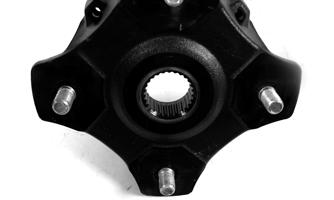
PR290
4.Secure the hub assembly with the hex nut. Tighten only until snug. 5.Secure the brake caliper to the knuckle with two new
“patch-lock” cap screws. Tighten to 20 ft-lb (27.2
N-m).

XR263A
6.Using an appropriate hub retaining wrench, tighten the hub nut (from step 4) to 200 ft-lb (271 N-m); then install and spread a new cotter pin making sure each side of the pin is flush to the hex nut. NOTE: If the cotter pin does not line up, always tighten to the next alignment.

XR291
7.Install the wheel and tighten the wheel nuts in 20 ft-lb (27.2 N-m) increments to a final torque of 40 ft-lb (54.4 N-m) (steel wheel), 60 ft-lb (81.6 N-m) (aluminum wheel w/black nuts), or 80 ft-lb (108.8
N-m) (aluminum wheel w/chrome nuts). 8.Remove the ATV from the support stand.
Hand Brake Lever/Master Cylinder Assembly
NOTE: The master cylinder is only serviceable as an assembly. REMOVING 1.Slide a piece of flexible tubing over one of the wheel bleeder valves and direct the other end into a container. Remove the reservoir cover; then open the bleeder valve. Allow the brake fluid to drain completely. NOTE: Compressing the brake lever several times will quicken the draining process.
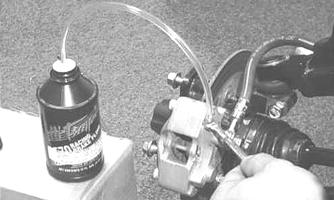
AF637D
2.Place an absorbent towel around the connection to absorb brake fluid. Remove the banjo-fitting from the master cylinder. Account for two crush washers and a banjo-fitting bolt.
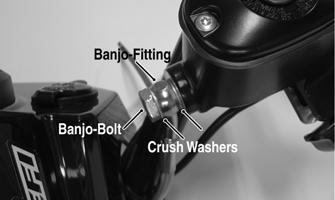
XR364A
CAUTION
Brake fluid is highly corrosive. Do not spill brake fluid on any surface of the ATV.
3.Remove the snap ring and pivot pin securing the brake lever to the master cylinder housing; then remove the brake lever and set aside. 4.Dislodge the brake light switch from the master cylinder housing by gently pressing it toward the pivot pin hole in the housing; then lay it aside leaving the switch and wiring harness connected.
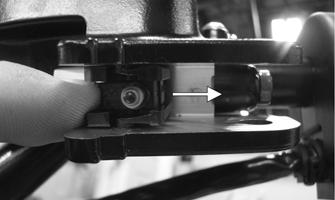
XR365A
5.Remove the clamp screws securing the brake housing to the handlebar; then remove the assembly from the handlebar.
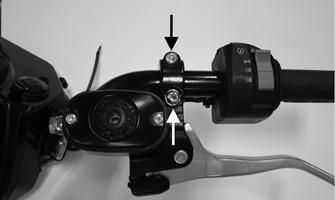
XR366A
INSPECTING 1.Inspect the pin securing the brake lever for wear. 2.Inspect the brake lever for elongation of the pivot hole. 3.Inspect the reservoir for cracks and leakage. 4.Inspect the banjo-fitting for cracks and deterioration and the condition of the fittings (threaded and compression). 5.Inspect the brake light switch for corrosion, cracks, missing or broken mounting tabs, or broken and frayed wiring. NOTE: If the brake light switch is determined to be inoperable, see Electrical System. INSTALLING 1.Position the brake housing on the handlebar. Secure with clamp screws; then tighten securely.
XR366A
2.Using two new crush washers, connect the banjo-fitting to the master cylinder; then secure with the banjo-fitting bolt. Tighten to 20 ft-lb (27.2 N-m).

XR364A
3.Gently press the brake light switch into the housing (left to right) until the mounting tabs snap into the four locating holes; then install the brake lever, pivot pin, and snap ring.

XR365A
4.Bleed the brake system (see Periodic Maintenance/Tune-up).
Hydraulic Brake Caliper
! WARNING
The manufacturer recommends that only authorized ATV dealers perform hydraulic brake service. Failure to properly repair brake systems can result in loss of control causing severe injury or death.
REMOVING/DISASSEMBLING 1.Secure the ATV on a support stand to elevate the wheel; then remove the wheel.
! WARNING
Make sure the ATV is solidly supported on the support stand to avoid injury.
! WARNING
Never let brake fluid contact the eyes. Damage to the eyes will occur. Always wear appropriate protective safety goggles and latex gloves when handling brake fluid.
2.Drain the brake fluid from the caliper, hose, and master cylinder through the bleed screw by pumping the brake lever/pedal.

PR235
CAUTION
Brake fluid is highly corrosive. Do not spill brake fluid on any surface of the ATV and do not reuse brake fluid.
NOTE: Whenever brake components are removed, disassembled, or repaired where brake fluid is exposed to air, drain all fluid and replace with new DOT 4 brake fluid from an unopened container. Brake fluid readily absorbs moisture from the air significantly lowering the boiling point. This increases the chance of vapor lock reducing braking power and increasing stopping distance. 3.Remove the brake hose from the caliper and close the bleed screw; then remove the caliper. 4.Compress the caliper holder against the caliper (opposite the O-ring side) and remove the outer brake pad; then remove the inner brake pad. NOTE: If brake pads are to be returned to service, do not allow brake fluid to contaminate them.
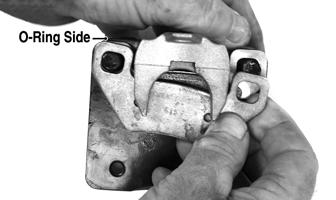
PR237A PR239B
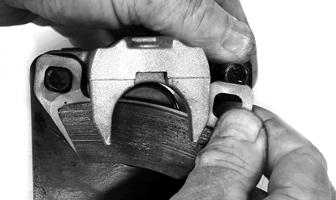
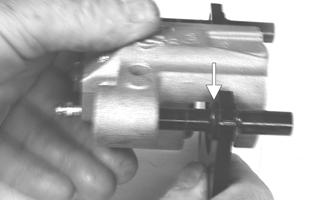
NOTE: The O-ring is used for shipping purposes and provides no function in operation. 6.Cover the piston end of the housing with a shop towel; then keeping fingers clear of piston travel, apply compressed air to the fluid port to blow the piston free of the housing. Account for two seal rings in the housing.
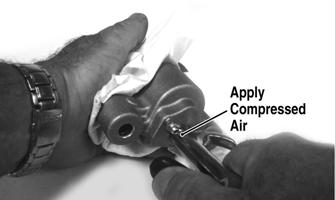
PR713A
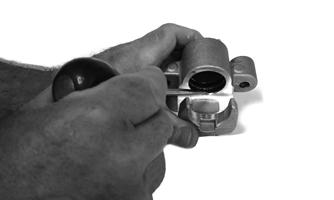
PR715
! WARNING
Make sure to hold the towel firmly in place or the piston could be ejected from the housing causing injury.
7.Using an appropriate seal removal tool, carefully remove the seals from the brake caliper housing; then remove four O-rings from the brake caliper housing noting the location of the different sized
O-rings. Discard all seals, O-rings, and crush washers.
CLEANING AND INSPECTING 1.Clean all caliper components (except the brake pads) with DOT 4 brake fluid. Do not wipe dry. 2.Inspect the brake pads for damage and excessive wear.
NOTE: For measuring brake pads, see Periodic Maintenance/Tune-up. 3.Inspect the brake caliper housings for scoring in the piston bores, chipped seal ring grooves, or signs of corrosion or discoloration. 4.Inspect the piston surface for scoring, discoloration, or evidence of binding or galling. 5.Inspect the caliper holder for wear or bending. ASSEMBLING/INSTALLING 1.Install new seals into the brake caliper housing and apply a liberal amount of DOT 4 brake fluid to the cylinder bore of the housing, seals, and brake piston.
CAUTION
Make sure the seals are properly in place and did not twist or roll during installation.

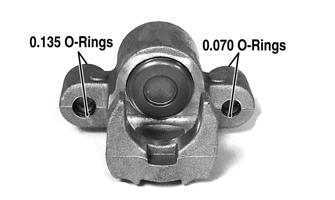
PR715
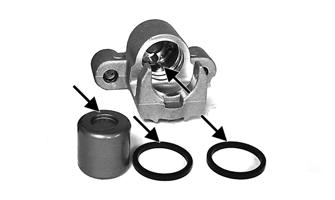
PR717A
2.Press the piston into the caliper housing using hand pressure only. Completely seat the piston; then wipe off any excessive brake fluid.
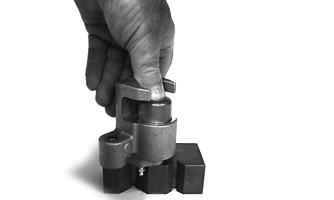
PR711A
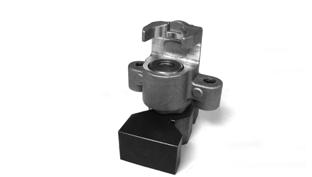
PR712
3.Apply high-temperature silicone grease (supplied with the O-ring kit) to the inside of the caliper holder bores and O-rings; then install the four O-rings into the caliper.
PR719C
4.Install the caliper onto the caliper holder making sure the caliper and holder are correctly oriented. NOTE: It is very important to apply silicone grease to the O-rings and caliper bores prior to assembly.
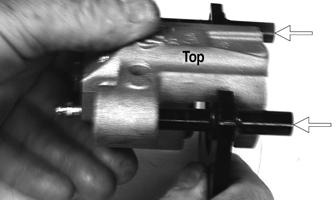
5.Making sure brake fluid does not contact the brake pads, compress the caliper holder toward the caliper and install the inner brake pad; then install the outer pad.
CAUTION
If brake pads become contaminated with brake fluid, they must be thoroughly cleaned with brake cleaning solvent or replaced with new pads. Failure to do so will result in reduced braking and premature brake pad failure.

PR238 PR239
6.Place the brake caliper assembly into position and secure with new “patch-lock” cap screws. Tighten to 20 ft-lb (27.2 N-m). 7.Place a new crush washer on each side of the brake hose fitting and install it on the caliper. Tighten to 20 ft-lb (27.2 N-m). 8.Fill the reservoir; then bleed the brake system (see
Periodic Maintenance/Tune-up).
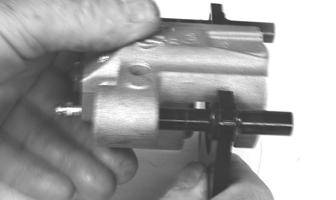
9.Install the wheel and tighten the wheel nuts in 20 ft-lb (27.2 N-m) increments to a final torque of 40 ft-lb (54.4 N-m) (steel wheel), 60 ft-lb (81.6 N-m) (aluminum wheel w/black nuts), or 80 ft-lb (108.8
N-m) (aluminum wheel w/chrome nuts). 10.Remove the ATV from the support stand and verify brake operation.
! WARNING
Never use brake fluid from an open container or reuse brake fluid. Moisture-contaminated brake fluid could cause vapor build-up (expansion) during hard braking resulting in greatly increased stopping distance or loss of control leading to injury or death.
Troubleshooting Drive System
Troubleshooting Brake System
Problem: Power not transmitted from engine to wheels Condition Remedy
1. Rear axle shafts serration worn — broken 1.Replace shaft
Problem: Power not transmitted from engine to either front wheel
Condition Remedy 1. Secondary drive — driven gear teeth broken 1.Replace gear(s) 2. Propeller shaft serration worn — broken 2.Replace shaft 3. Coupling damaged 3.Replace coupling 4. Coupling joint serration worn — damaged 4.Replace joint 5. Front drive — driven bevel gears broken — damaged 5.Replace gear(s) 6. Front differential gears/pinions broken — damaged 6.Replace gears — pinions 7. Sliding dogs/shaft fork worn — damaged 7.Replace gear(s) 8. Front drive axle worn — damaged 8.Replace axle 9. Front drive axle serration worn — damaged 9.Replace axle
Problem: Braking poor Condition Remedy
1. Pad worn 1.Replace pads 2. Pedal free-play excessive 2.Replace pads 3. Brake fluid leaking 3.Repair — replace hydraulic system component(s) 4. Hydraulic system spongy 4.Bleed hydraulic system — correct or repair leaks 5. Master cylinder/brake cylinder seal worn 5.Replace master cylinder
Problem: Brake lever travel excessive Condition Remedy
1. Hydraulic system entrapped air 1.Bleed hydraulic system 2. Brake fluid low 2.Add fluid to proper level 3. Brake fluid incorrect 3.Drain system — replace with correct fluid 4. Piston seal — cup worn 4.Replace master cylinder
Problem: Brake fluid leaking Condition Remedy
1. Connection joints loose 1.Tighten joint 2. Hose cracked 2.Replace hose 3. Piston seal worn 3.Replace brake caliper

